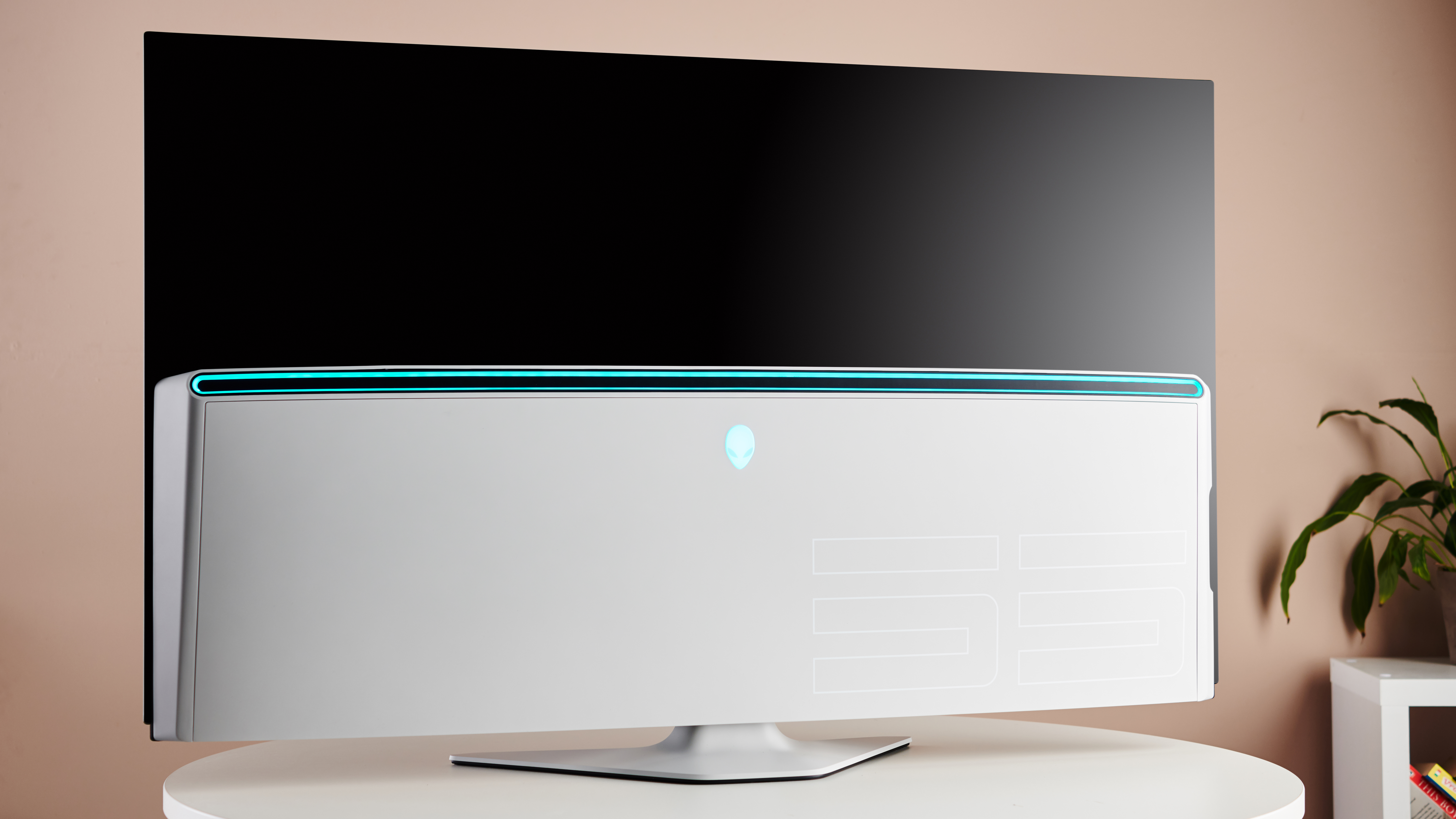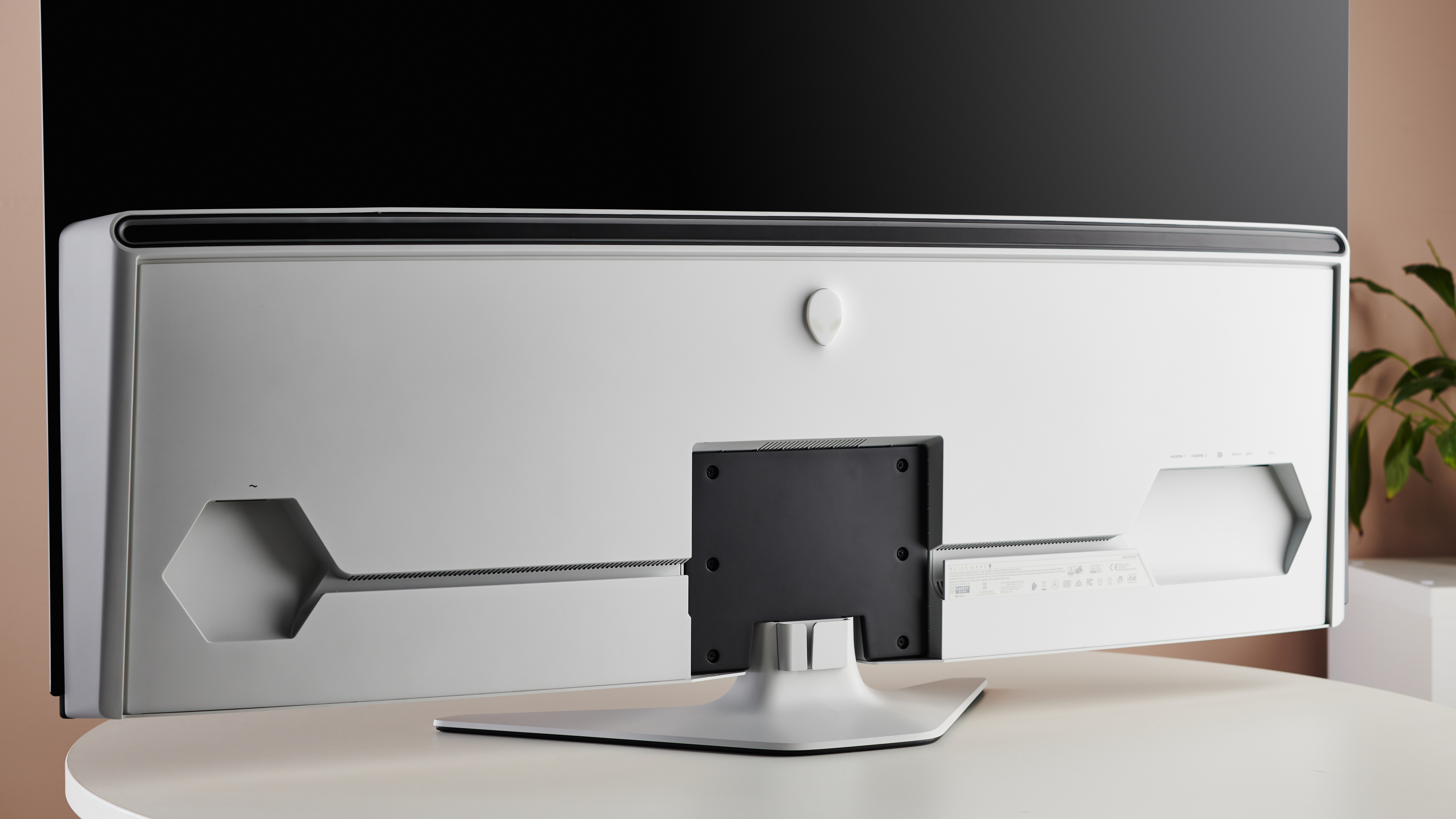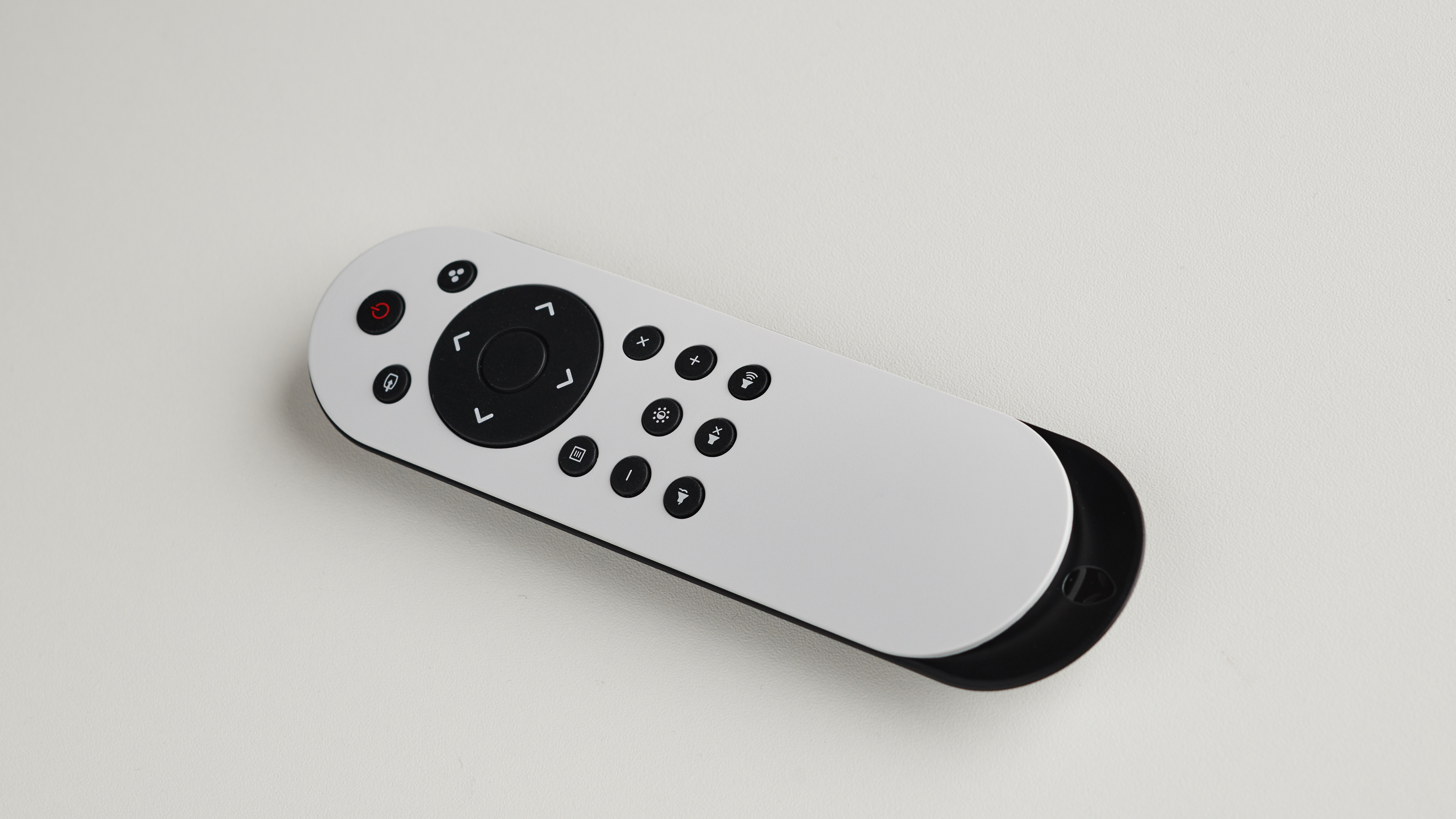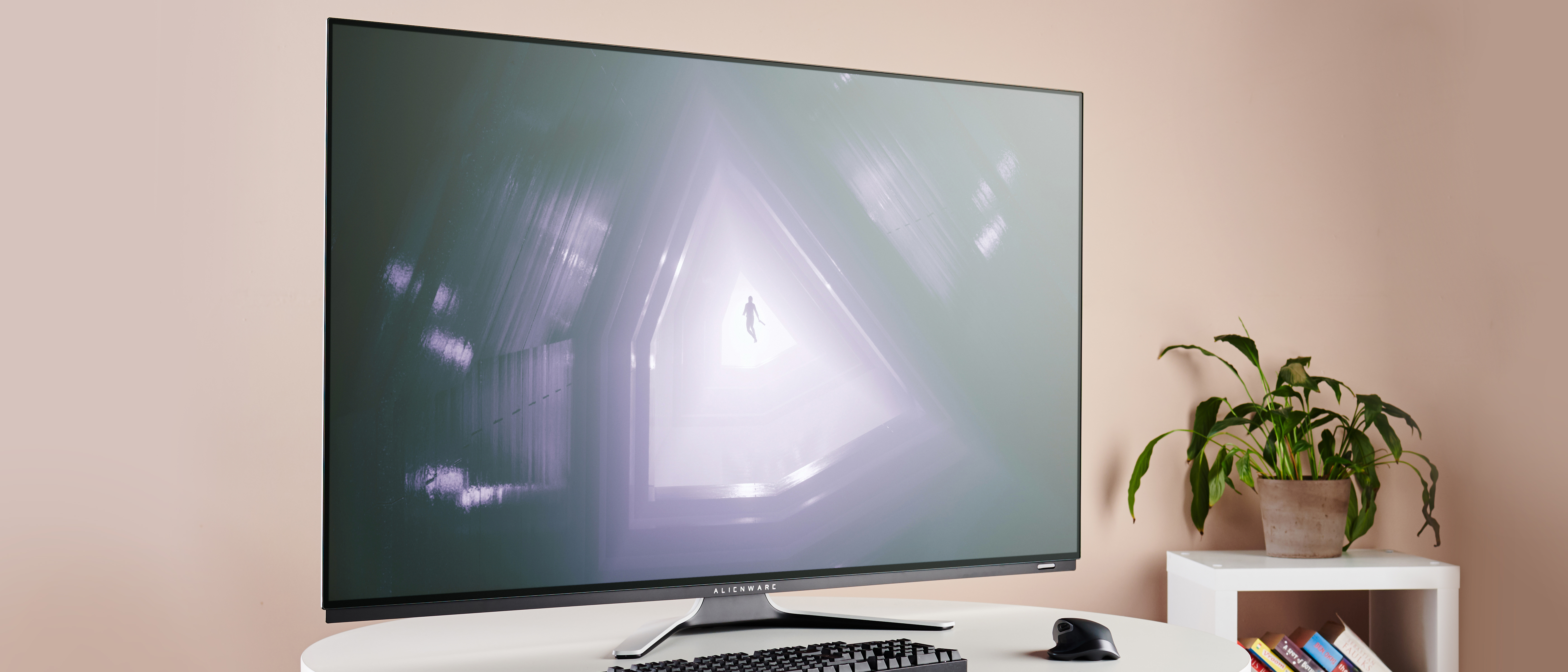TechRadar Verdict
The Alienware AW5520QF is a huge 55-inch OLED gaming monitor that can make any game look cinematic thanks to its large size, 4K resolution and 120Hz refresh rate. However, it’s also very expensive, and doesn’t quite do enough to justify the steep price tag.
Pros
- +
Huge
- +
4K resolution is great
- +
Lovely design
- +
Freesync support is a nice feature
Cons
- -
Extremely expensive
- -
Not that bright
- -
Risk of burn-in
- -
No HDMI 2.1
Why you can trust TechRadar
While reviewing the Alienware AW5520QF, Dell’s huge 55-inch OLED gaming monitor, we were struck with the thought: when does a monitor become a television?
After all, while Dell markets the Alienware AW5520QF as a gaming monitor, it has more in common with TVs than with most monitors that grace our desks.
That includes the obvious size of the thing – a 55-inch screen is more suited to a living room than an office, after all. Plus, there’s the array of ports for hooking up games consoles and set top boxes (as well as a gaming PC), and it even comes with a remote control.
However, there are certain aspects that makes the Alienware AW5520QF a monitor and not a TV. For one, it doesn’t have a built-in TV receiver, which means unlike televisions, you can’t plug in an aerial and get TV channels.
It has also a number of features you’d usually find in a gaming monitor rather than a standard TV, such as a high 120Hz refresh rate, AMD FreeSync support and low input latency. This makes it a great choice for gamers. However, do those extra features make it worth getting the Alienware AW5520QF instead of a more affordable 55-inch 4K TV? Let’s find out.

Price and availability
Gaming monitors, especially those with ultra-high resolutions and super-fast refresh rates, can be very expensive devices, so when you’re looking at a gaming monitor that’s a huge 55-inches in size – well, don’t go expecting anything too affordable.
At a huge $3,999.99 (£3,199.99, around AU$6,000), this is an incredibly expensive gaming peripheral, even by Alienware’s standards. Unless you’ve got an incredibly specced-out gaming rig, it’s likely that this monitor is more expensive than your entire PC. It’s a huge investment.
It’s also a huge price tag at a time when the prices for 4K TVs – even OLED ones – are dropping. For example, you can get a 55-inch Philips 55PUS6754 Ambilight HDR 4K TV for just £549 (around $700, AU$1,000).
Meanwhile, the 55-inch LG C9, which is currently our pick for the best 4K OLED TV, costs $2,499/£2,499/AU$3,899 – still a fair bit cheaper than the Alienware AW5520QF.
That means the Alienware AW5520QF really needs to show that its monitor-exclusive features are worth the price premium – because on paper at least, it doesn’t look like a good value.

Design
The Alienware AW5520QF’s design is pretty much what we’ve come to expect from an Alienware monitor – just scaled up – and you know what? It works. Blowing up the design of some gaming monitors from other manufacturers, with all their ‘extreme’ gamer aesthetics and glowing RGBs would look horrible, but Alienware’s relatively retrained designs look just as good on this 55-inch behemoth as it does on Dell’s smaller monitors.
The screen itself is seriously thin, though the bottom half of the screen is thicker, where the bulk of the hardware and connectors are kept. From the front then, you’d think this was a regular TV – which is a good and a bad thing. It means it will fit into any front room without looking out of place, but it also means it’s not immediately apparent what the extra money you paid for has got you.
Around the back there’s an LED light and Alienware icon – both of which can be configured using AlienFX software, and it can be used to sync the lighting with any other compatible Alienware products. It’s one of the few nods to the AW5520QF’s gaming heritage, and we think it strikes the right balance between appealing to gamers without being too garish.

The rear panel is silver plastic, and is attached via magnets. Removing it gives you access to the various ports, which includes a DisplayPort 1.4b – essential for running 4K at refresh rates higher than 60Hz – three HDMI 2.0 and four USB 3.1 ports. There’s also a headphone jack. The ports are nicely hidden away with the plastic panel attached, and the wires can be routed through channels cut into the body of the TV and down through the stand, making cable management easy, and leading to a very clean look.
However, you may note the lack of HDMI 2.1 ports. While there’s not a lot of devices that make full use of HDMI 2.1 yet, which will offer even higher resolutions and refresh rates, it does mean the Alienware AW5520QF is not as futureproof as its price tag suggests it should be. When HDMI 2.1 becomes more common, you may find the AW5520QF feels a bit outdated – not great, considering the price, and how many competing TVs have HDMI 2.1 support already.
It also means you need to use the DisplayPort for resolutions and framerates above 4K at 60 FPS. Depending on what ports next gen consoles come with, that could be an issue.

Overall, the Alienware AW5520QF looks fantastic, with enough style to appeal to many gamers without alienating people with more conservative tastes. It certainly won’t look out of place in a front room, which unlike other gaming monitors, is where you’re most likely going to have it set up.
Performance
In case you haven’t figured it out, 55-inches is an insane size for a monitor – gaming or otherwise. Just fitting this thing on your desk is hard enough. But, once you’re all plugged in and up and running – you’ll need two of you to put the monitor together, as this thing is a wonderful combination of big and delicate – it acts pretty much like a normal monitor.
As a 4K OLED set, Windows 10 of course looks gorgeous on it – though it originally had scaling as 300%, leading to very large text and icons. Putting it at 100% gave us a very sharp image and huge amounts of desktop space. If you’re tempted to use this as a standard monitor, then you may like the extra space the 4K resolution affords, and because the screen is so darn huge, it means that even at 4K, text, windows and images are all large enough to use comfortably. The 120Hz refresh rate also makes Windows 10 feel incredibly smooth when used.
What’s not comfortable, however, is sitting up close to the Alienware AW5520QF and using it on a desk, as you would a normal monitor. The AW5520QF towers above you, and you’ll find yourself craning your neck upwards to view the entire thing.

To best use this screen, you’ll want to be sitting a decent distance away from it - much like you would with a standard TV. That means playing games with a wireless controller, or investing in a wireless mouse, keyboard and a place to rest them on.
We played both Control and Gears 5 at 4K, and thanks to our mighty rig (with two Nvidia Titan Xp graphics cards), we were able to get both games to play at 4K resolution at frame rates well above 60 FPS. That means straight away, you’re getting a graphical experience that would not be possible on consoles or with most standard TVs.
However, this is on a very powerful PC with very expensive hardware. You’ll need an impressive PC to run modern games at 4K and make use of that 120 refresh rate.
The games did look fantastic though, and the high refresh rate and low input lag made them feel impressively fast and responsive.
However, it’s not all good news. We did notice some artifacts when switching between games and when changing visual settings in-game. They disappear after a few seconds, but it can be annoying.
Also, we’ve seen OLED TVs that look amazingly bright and vibrant thanks to the tech’s impressive contrast ratio. However, the AW5520QF doesn’t really make use of this, because it has noticeably lower brightness than many competing TVs – with a maximum brightness of 400 nits. That means its visual impact is dulled compared to brighter TVs – and its HDR implementation, which depends on the contrast between light and dark, is severely compromised.
On its own, you may not notice it too much, but comparing the Alienware AW5520QF to more vibrant TVs, and it can really make the AW5520QF look disappointing – especially if the TV is hundreds, if not thousands, of dollars or pounds cheaper.
The AMD FreeSync technology is a welcome addition to the AW5520QF that keeps games running smoothly and without screen tearing. If you have compatible hardware, it can make a pleasant difference to how games perform and look – but again, you need the right hardware. The AW5520QF doesn’t support Nvidia’s rival G-Sync technology, which is more widely-used by gaming laptops and PCs – mainly because they have Nvidia graphics cards. We’re also seeing a number of large-screen monitors with G-Sync capabilities, such as the Nvidia Big Format Gaming monitors, hit the market, and LG is bringing out a range of OLED TVs with G-Sync compatibility.
All of these will compete with the Alienware AW5520QF, which could make it harder for Dell to justify its price.
As a gaming monitor, the Alienware AW5520QF does a great – and sometimes stunning – job, however, but it never feels like it’s worth the high asking price. There are also concerns about burn-in, where images left on the OLED panel can remain, albeit faintly, for a while afterwards, and in some extreme cases, permanently.
While we didn’t experience any issues with burn-in on the Alienware AW5520QF during our time with it, we didn’t have long enough to test the long-term effects. If you’re playing long sessions of a game where certain elements remain on the screen – such as menus – for hours on end, then there is a risk of burn-in. The Alienware AW5520QF comes with some built-in tools to fix any effects, but there will be people who will be mightily annoyed if their super-expensive gaming monitor begins showing signs of burn-in.
Verdict
So, what to make of the Alienware AW5520QF? It’s a tough one. In many ways this is a breath-taking gaming monitor. It’s sheer size, combined with the 4K resolution and high refresh rates, can turn even the most humdrum game into a thrilling cinematic experience. You’ll need a powerful PC to take advantage of the Alienware AW5520QF to its fullest, but if you do, you could be very impressed.
The design is gorgeous as well, and will fit into any modern living room. However, if you’re looking for a monitor to put on a desk or use in an smaller space – this is not the one for you.
While there’s a lot to like about the Alienware AW5520QF, it falls short in a lot of ways as well. It’s main issue is that it’s simply not as bright as other monitors and TVs. This dulls any visual impact from HDR, and for a screen of this size, that’s a real shame. Dell might have played it safe with the maximum brightness of the Alienware AW5520QF to reduce the chance of burn-in, but that’s little compensation.
There’s also the lack of HDMI 2.1 and G-Sync, which limits the future proof nature of this monitor. When you’re spending that much money on a monitor, you don’t want to feel like your new purchase is outdated too soon.
And the price is the biggest sticking point. This is a hugely expensive monitor, especially compared to 4K TVs that offer similar visual quality. Sure, they may not include some of the gaming monitor features that the Alienware AW5520QF possesses, but then you have to consider if they are worth the extra money? For most gamers, we’d say no.

Matt is TechRadar's Managing Editor for Core Tech, looking after computing and mobile technology. Having written for a number of publications such as PC Plus, PC Format, T3 and Linux Format, there's no aspect of technology that Matt isn't passionate about, especially computing and PC gaming. He’s personally reviewed and used most of the laptops in our best laptops guide - and since joining TechRadar in 2014, he's reviewed over 250 laptops and computing accessories personally.
